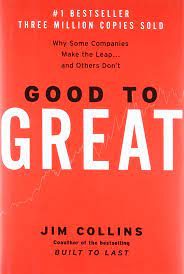Summary of Good to Great: What can we learn from Jim Collins’ book?
I’ve read “Good to Great” and its follow-up “Great By Choice” countless times, most recently at Christmas. It is good to go back to the source, especially since certain theories are often reinterpreted or modified by others. You have to be careful not to lose the original detail and definition, like you’re photocopying an image over and over until it fades. I was again struck by his key themes because I think they are so relevant to our customer journey. Or want to be on.
If there was one criticism of “Good to Great” when it was first published, it’s that this longitudinal study of what makes companies “great” focused on large organizations. In response, Collins walked away and wrote “Great by Choice” looking at small businesses that, as they grew, decided to be great. What is fascinating is that he concluded that there was little difference when he compared and contrasted large companies to smaller ones. All good and great companies shared the same characteristics.
What were these characteristics? And what are the main lessons of “Good to Great”?
1. Good to excellent companies have “level 5 leadership”
In “Good to Great,” Jim Collins describes how he debated with his research team about the nature of leadership in good and great companies. There was something about their CEOs that was different. Eventually, they settled on the characteristics of humility and a willingness to do the right thing for the good of the company, not themselves. Collins defined the different levels, with level 5 leadership at the top.
In my experience, Collins was right on target. Of the CEOs I coach, the most successful share a complete lack of arrogance. They are humble people – understanding that they don’t know everything. And, without fail, they are driven to do the right thing by their employees, their shareholders and their customers.
Just this morning I was talking with a client who demonstrated level 5 leadership. Yes, his business model has proven successful and he has grown rapidly. But for him, a greater reward was being able to change more lives. He saw his business as a way to do this for his employees and customers. When I think back to my time as MD of Peer 1, it was the same. The numbers were excellent. We have gone from zero to £30m in five years. But my satisfaction came from the profound changes we brought to the lives of the people who came to work with us. Where it got them. Our company has been a slingshot for so many, propelling them to bigger, better, and bigger things. I get goosebumps just thinking about it! I’m so proud of that personal impact.
2. Get the right people on the bus
For me, this is the most important of all the lessons from “Good To Great”. If you don’t remove anything else, that’s the only thing you always need to remember. Nothing is more important to a company than the talent it employs – what Jim Collins calls “getting the right people on the bus”.
I talk about it a lot in my coaching. But when I reread “Good to Great” over Christmas, I realized I had to do it even more. In fact, I must be almost manic to find the right people. Maybe I wasn’t tough enough on some of my clients. I know from experience how difficult it is to do the work necessary to reach an executive team of A-Players. When I think back to my Rackspace and Peer 1 days, we definitely had the right people on the bus. But we never came close to the magic goal of 80-90% A players. getting a job with us than getting into Oxford. It’s great to see that they still use that analogy in the US saying it’s harder to get into Harvard).
So this year, I’m going to focus on it even more. We’ll be using Patrick Lencioni’s Working Genius tool with Gallup Strengths – the goal is to give executive teams and business leaders the vocabulary to have tough conversations and hold each other accountable. We will work on trust and productive conflict. People need to learn this stuff through experience. This is where the value of OKRs comes in. I help clients build a cultural and behavioral framework, then I use OKRs to create a performance measure. It’s where these two things intersect that you find your A-Players.
In “Good to Great”, Jim Collins points out that you need the right people on the bus before figuring out where you want it to go. It is therefore fundamental. I’ve worked with clients who said they wanted to make this transition, but found it too difficult. They weren’t ready to replace colleagues or move them to other roles. But if you don’t, you’ll end up with the wrong culture. Your B-Players will set the standards for behavior and you will build your business around them. You need A-Players to set the tone.
3. To be great, companies must face the brutal facts
Jim Collins describes the experience of James Stockdale – the highest-ranking American POW in the Vietnam War – in “Good to Great”, calling it “the Stockdale paradox”.
Stockdale has been locked down for a long, long time – over eight years. At this time, many of his fellow inmates gave up the will to live. They were the optimists. Those who said, we’ll be out by Christmas or Easter or their next birthday and finally gave up hope. In contrast, Stockdale lived hand to mouth, accepting the brutal reality of his situation. But he never lost faith that he would make it out alive and that it would become the defini…










Be the first to review “Good to Great”